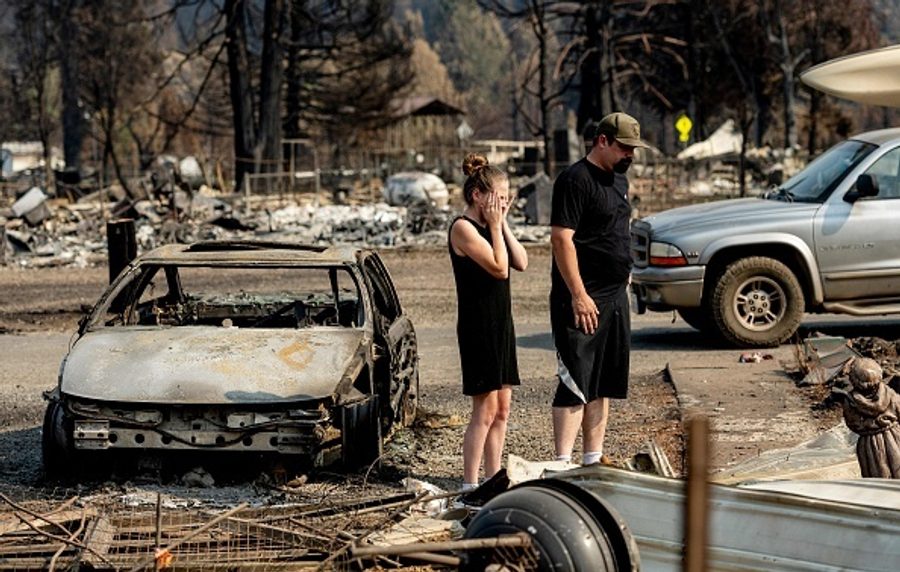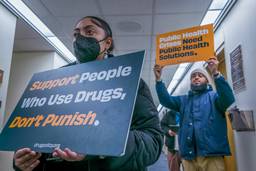After Getting Burned By Wall Street, California Fire Victims Fight To Reclaim Their Power
California utility company PG&E has settled, but many fire victims are still waiting to see their full payout.
Jordan Allyn

EUGENE, ORE. — Three and a half years after the Camp Fire incinerated the town of Paradise, Calif., Shelli Bryan, 66, still waits for relief money to rebuild her life.
“We’re living on the edge of poverty beyond any thing I could have ever imagined,” Bryan says.
A spark from a faulty transmission line, owned by private utility company Pacific Gas and Electric (PG&E), ignited the 153,336-acre blaze that destroyed 18,804 structures and killed 85 people in November 2018. To shield itself from billions of dollars of liability, PG&E filed for Chapter 11 bankruptcy protection in January 2019. As part of a settlement in December 2019, the company pledged $13.5 billion to fund the Fire Victim Trust, which would provide payments to victims of the 2015 Butte Fire, the 2017 North Bay Fires and the 2018 Camp Fire — all sparked by PG&E’s grid. Victims of the 2016 Ghost Ship Fires were also compensated through a settlement with PG&E where the company claimed no fault.
Today, only 65% of the 69,000 victims have received any relief money.
Soot damage rendered the home Bryan was renting unlivable and destroyed most of her belongings. Her storage unit also burned down. Cost of living increases have forced her out of California as she struggles to cover rising rent and medical bills. She did collect a preliminary payment of $34,000 from the Fire Victim Trust — on which she owed $26,000 in taxes. She asked her lawyer when she should expect the rest of her $187,00 payment, but was told “the same thing she says all the time: ‘We don’t know.’”
Under PG&E’s bankruptcy agreement, $6.75 billion of the pool for victim repayment was in cash; the other part was in 477 million shares of PG&E stock. The Fire Victim Trust was underfunded on the assumption that the stock price would eventually increase from $9 to $14.15 a share, but the stock price has only risen to about $12 a share. In February, the Fire Victim Trust completed a major selloff of 40 million shares of PG&E stock, which added around $480 million in cash to the fund but still left victims $80 million short. To make up the difference, the remaining shares now have to sell at $14.
Tammy Spirlock, 51, who lost her Magalia, Calif., home in one of the fires, was suspicious of the deal from the very beginning. “As soon as I heard that we were going to be paid half stock, I didn’t like that.” Her father had worked for PG&E for 33 years, and she had watched the price waver.
Spirlock tried to organize fire victims to vote against the 2019 settlement, but ultimately more than 85% approved it.
“If I had been told and knew exactly what the implications of a yes vote would mean,” Bryan reflects, “I would never have been part of the claim at all.”
Republican California State Assemblyman James Gallagher proposed a new bill in February to “ensure that the Fire Victim Trust is fully funded.” In committee, the bill was amended to, instead, mandate a review of whether PG&E’s actions hurt its stock value.
“We can tell you why the stock isn’t performing — because they keep burning things down,” Spirlock says. PG&E has also been accused of being responsible for the 2019 Kincade, 2020 Zogg and 2021 Dixie Fire.
“The shareholders knew exactly what was going to happen, so they bailed and took their shares with them, dropping our amounts even more,” Bryan says. Multiple Wall Street hedge funds involved in brokering the settlement deal unloaded 250 million shares of PG&E after it left bankruptcy, driving down the share price. The funds had received 169 million shares for free, amounting to $1.5 billion, as an “equity backstop” to maintain the price point — but without any stipulation that they couldn’t just sell the stock.
It was the “largest [giveaway] of its kind in the history of corporate bankruptcy,” according to a KQED and California Newsroom investigation.
As the first corporation to be held solely liable for a climate related disaster, PG&E is a test case. Legal scholar Alexander Gouzoules argues the bankruptcy system is not equipped to deal with disasters of this magnitude, and that using shares as compensation for creditors doesn’t work when “the shares … will continue to be impacted by the continuing risk of wildfires.”
Victims of the Dixie Fire will receive cash from PG&E, according to an April settlement, and California has now created a wildfire fund not reliant on share value.
But the Reclaim Our Power! Utility Justice Campaign says putting customers on the hook for victim compensation creates a “license to burn” for PG&E, rather than an incentive to update infrastructure.
Founded in 2018, Reclaim Our Power! aims to replace PG&E with a “safe, reliable, community-and worker-owned energy system that benefits all Californians.” As far as using PG&E shares to compensate fire victims goes, campaign coordinator Mari Rose Taruc says: “That is from the twisted minds of Wall Street to force fire survivors into that situation.”
Jordan Allyn is a Chicago-based reporter and an In These Times editorial intern.





